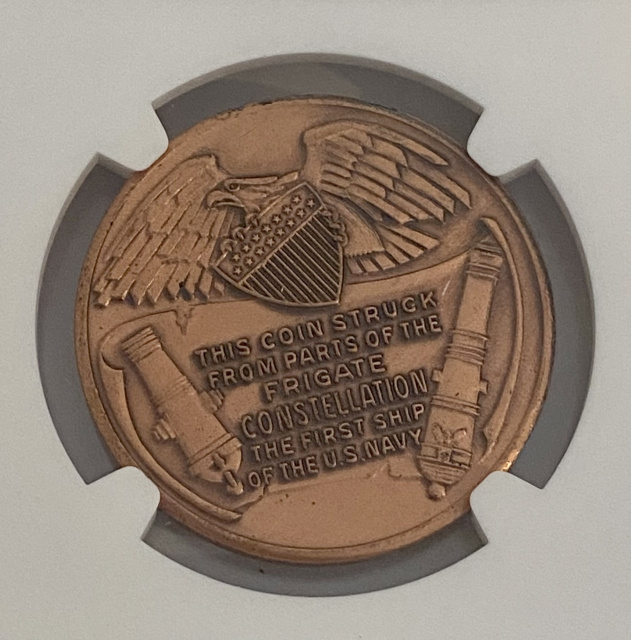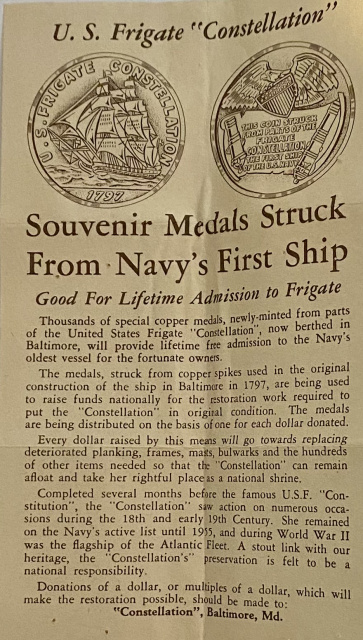c. 1950's Admission Medal U.S. Frigate "Constellation" NGC MS65 Finest Known
Price: $150.00
Availability: in stock
Prod. Code: Shipwreck Buried Treasure
c. 1950's Admission Medal U.S. Frigate "Constellation" NGC MS65 Finest Known
*AMERICA'S FIRST SHIP* Medal is made from the material of the original ship!
For over 200 years, Constellation ships have navigated the world's oceans defending America's interests.
In 1797, the first ship of the U.S. Navy, the USF "frigate" Constellation was commissioned. This frigate's name originated from the flag of the Continental Congress.
Because of her swift sailing speed and handling ability, USF Constellation soon became known as the "Yankee Racehorse."
1797-1853: US Frigate Constellation - America's First Ship
The first Constellation initially was a frigate designed by naval constructors Joshua Humphreys and Josiah Fox. However, plans were later altered in its execution by builder David Stodder, and superintendent of shipbuilding, Captain Thomas Truxtun. After the construction of Constellation was finished at Sterrett Shipyard, Baltimore, MD, she launched on September 7, 1797.
Constellation convoyed American merchantmen at the outset (from June through August 1798), before sailing for the West Indies to protect United States' commerce. Under the command of Captain Thomas Truxtun, she sailed for the Caribbean in December 1798. Subsequently, on February 9, 1799, the Constellation captured a French 40-gun frigate, L'Insurgente, in battle off Nevis, West Indies. In a hard-fought victory, she brought her prize into port. In the succeeding months, Constellation additionally encountered and seized two French privateers, Diligent and Union.
After a brief voyage under Captain Samuel Barron, Constellation was later commanded once more by Truxtun. Under this new command change, she sailed for the West Indies in December 1799.
On the evening of February 1, 1800, the Constellation engaged with a 52-gun frigate, the Vengeance, in a lengthy, furious battle. Vengeance twice struck her colors (lowered her flag in surrender) and was close to sinking. However, with a stroke of luck, Vengeance utilized the darkness of the night to escape from Constellation, who was unable to pursue further because of the loss of her mainmast.
In May 1800, Constellation additionally gained more recognition for recapturing three American merchantmen. At the end of the Quasi-War with France, Constellation returned to home waters, where misfortune awaited her. While anchoring in Delaware Bay on April 10, 1801, the ship got caught in winds and an ebb tide that laid her over on her beam ends, causing extensive repairs.
Under Commodore Robert Morris, and later, under Commodores Samuel Barron and John Rodgers, Constellation sailed with the squadron that served in the blockade of Tripoli in May 1802. She traveled widely throughout the Mediterranean during 1804 to show the flag of the United States in demonstration of our nation's seapower strength.
In June 1805, Constellation evacuated a contingent of U.S. Marines and diplomatic personages from Derne at the conclusion of a fleet-short operation against Tripoli. Additionally, she took part in a squadron movement against Tunis that culminated in peace terms in August 1805. She later returned to the United States in November 1805, mooring at Washington where she was later placed in ordinary until 1812.
Constellation then underwent extensive repairs at Washington during 1812 and 1813. With the advent of war with England approaching, Constellation was dispatched to Hampton Roads under the command of Captain Charles Stewart. Shortly after her arrival in January 1813, Constellation was effectively blockaded by an imposing British fleet. Unable to reach the open sea, her presence protected fortifications at Craney Island.
In the wake of the War of 1812, naval action resumed against the Barbary powers that had enriched themselves considerably during the struggle with England. Constellation, attached to the Mediterranean Squadron under Commodore Stephen Decatur, sailed from New York on May 20, 1815 and joined in the capture of the Algerian frigate, Mashuda, on June 17, 1815. Treaties of peace soon ensued Algiers, Tunis, and Tripoli. Constellation remained with the squadron under Commodores William Bainbridge, Isaac Chauncey, and John Shaw to enforce the accords, returning to Hampton Roads in December 1817.
Except for brief periods under repair in 1828-29, 1832, 1834-35, and 1838-39, Constellation's career through the mid-point 19th century proved varied and colorful. From November 12, 1819 to April 24, 1820, she served as flagship of Commodore Charles Morris on the Brazil Station, which entailed protecting American commerce against privateers and supporting the negotiation of trade agreements with South American nations.
On July 25, 1820, she sailed for the first time to Pacific waters where she joined the Squadron of Commodore Charles Stewart. For two years, Constellation protected American shipping off the coast of Peru, an area where that erupted into revolt against Spain.
In 1827, Constellation acted briefly as flagship for the West India Squadron. She participated in a twofold mission involving the eradication of the last of the pirates and the interception of slavers operating in the area.
In August 1829, she cruised to the Mediterranean to watch over American shipping and to collect indemnities from previous losses suffered by U.S. merchantmen. En route to her station, she carried the American ministers to France and England to their posts of duty.
Arriving in the United States during November 1831, she underwent minor repairs and departed again for the Mediterranean in April 1832 where she remained until an outbreak of cholera forced her to sail for home in November 1834.
In October 1835, Constellation sailed for the Gulf of Mexico to assist in crushing the Seminole uprising. She landed shore parties to relieve the Army garrisons and sent her boats on amphibious expeditions. After a successful mission, she then cruised with the West India Squadron until 1838, serving part of this period in the capacity of flagship for Commodore Alexander Dallas.
During the 1840's, Constellation circumnavigated the globe. Serving as flagship to Captain Kearny and the East India Squadron in March 1841, her mission was to safeguard American lives, property against loss in the Opium War, and enable negotiation of commercial treaties.
Afterward, in May 1843, she arrived at the Hawaiian Islands to help keep them from becoming a British protectorate. Thereafter, she sailed homeward making calls at South American ports.
Ultimately laid up in ordinary at Norfolk, Virginia from 1845 to 1853, Constellation was broken up there in 1853.


